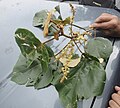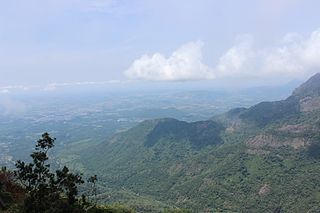
The Nilgiri Biosphere Reserve is a biosphere reserve in the Nilgiri mountains of the Western Ghats in South India. It is the largest protected forest area in India, spreading across Tamil Nadu, Karnataka and Kerala. It includes the protected areas Mudumalai National Park, Mukurthi National Park, Sathyamangalam Wildlife Sanctuary in Tamil Nadu; Nagarhole National Park, Bandipur National Park, both in Karnataka; Silent Valley National Park, Aralam Wildlife Sanctuary, Wayanad Wildlife Sanctuary, and Karimpuzha Wildlife Sanctuary in Kerala.

Madhuca longifolia is an Indian tropical tree found largely in the central, southern, north Indian plains and forests, Nepal, Myanmar and Sri Lanka. It is commonly known as madhūka, madkam, mahuwa, Butter Tree, mahua, mahwa, mohulo, Iluppai, Mee or vippa chettu. It is a fast-growing tree that grows to approximately 20 meters in height, possesses evergreen or semi-evergreen foliage, and belongs to the family Sapotaceae. It is adaptable to arid environments, being a prominent tree in tropical mixed deciduous forests in India in the states of Odisha, Chhattisgarh, Jharkhand, Uttar Pradesh, Bihar, Maharashtra, Andhra Pradesh, Madhya Pradesh, Kerala, Gujarat, West Bengal and Tamil Nadu.

Anacolosa densiflora is a species of plant in the Olacaceae family. Currently, it is an endangered species that is endemic to India.

Gluta travancorica is a species of plant in the family Anacardiaceae. It is endemic to the southern Western Ghats in India.
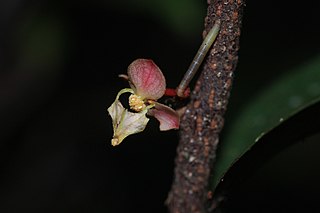
Orophea thomsonii or Thomson's Turret Flower is a species of shrub or small tree in the Annonaceae family. It is native to Kerala and Tamil Nadu in India and endemic to the Western Ghats mountain range.

Palaquium ravii is a species of tree in the family Sapotaceae. It is endemic to the Western Ghats mountains and native to Kerala and Tamil Nadu in India.

Phyllanthus anamalayanus is a species of plant in the family Phyllanthaceae. It is endemic to the Anamalai Hills in Coimbatore district in the state of Tamil Nadu, India. The species is a shrub or small tree occurring in the understorey of mid-elevation tropical wet evergreen forests in the Anamalai Hills, and is endemic to the Western Ghats. It is threatened by habitat loss.

Syzygium densiflorum is a species of evergreen tree in the family Myrtaceae. It is endemic to the Western Ghats mountains, India. The species is categorised as Vulnerable in the IUCN Red List.

Macaranga peltata is a plant found in northern Thailand, Sri Lanka and India. It is one of the most widely occurring early successional woody species in Sri Lanka, specially in low country wet zone. Some of the many common names include kenda - කැන්ද or kanda in Sri Lanka and chandada in India.

Mallotus philippensis is a plant in the spurge family. It is known as the kamala tree or red kamala or kumkum tree, due to the fruit covering, which produces a red dye. However, it must be distinguished from kamala meaning "lotus" in many Indian languages, an unrelated plant, flower, and sometimes metonymic spiritual or artistic concept. Mallotus philippensis has many other local names. This kamala often appears in rainforest margins. Or in disturbed areas free from fire, in moderate to high rainfall areas.

Diospyros candolleana, is a tree in the Ebony family, endemic to the Western Ghats of India and Sri Lanka. The trees are usually 20m tall, and found as subcanopy trees in wet evergreen forests up to 90m.
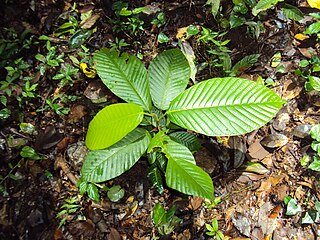
Dipterocarpus bourdillonii is a species of large tree in the family Dipterocarpaceae endemic to the Western Ghats principally in the state of Kerala in India. It is a Critically Endangered species according to the IUCN Red List of Threatened Species. It is a characteristic tree of the low-elevation tropical wet evergreen rainforests in the Western Ghats.

Cullenia exarillata is a flowering plant evergreen tree species in the family Malvaceae endemic to the rainforests of the southern Western Ghats in India. It is one of the characteristic trees of the mid-elevation tropical wet evergreen rainforests and an important food plant for the endemic primate, the lion-tailed macaque.

Bhesa indica is a flowering plant tree species in the Centroplacaceae family. It is distributed along the tropical wet evergreen forests of the Western Ghats of India. It is considered synonymous with Bhesa paniculata by some authors.

Trema tomentosa, commonly known as poison peach, is a shrub or tree in the family Cannabaceae native to the Indian subcontinent, south east Asia, through the islands of the south west Pacific, and the east coast and northern half of Australia.
Getonia is a monotypic genus of flowering plants belonging to the family Combretaceae. Its native range is India, Assam to Peninsula Malaysia.

Baccaurea courtallensis is a flowering plant evergreen tree species belonging to the family Phyllanthaceae. It is endemic to the Western Ghats mountains in India. It is a medium size understory tree frequent in tropical wet evergreen forests of the low and mid-elevations (40-1000m). It is a Near Threatened species according to the IUCN Red List of Threatened Species.

Cryptocarya anamalayana is a rare rainforest tree endemic to the southern Western Ghats, India. The specific epithet of the name refers to the Anamalai Hills, a major area of its distribution. The species considered endangered under the IUCN Red List of Threatened Species.

Diospyros paniculata, or the panicle-flowered ebony, is a species of tree in the ebony family. Endemic to the Western Ghats area of India and parts of Bangladesh, the species is currently listed as Vulnerable in the IUCN Red List.
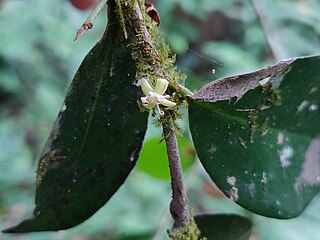
Drypetes wightii is an evergreen tree species endemic to the Western Ghats, India. The species is considered Vulnerable under the IUCN Redlist of Threatened Species.







